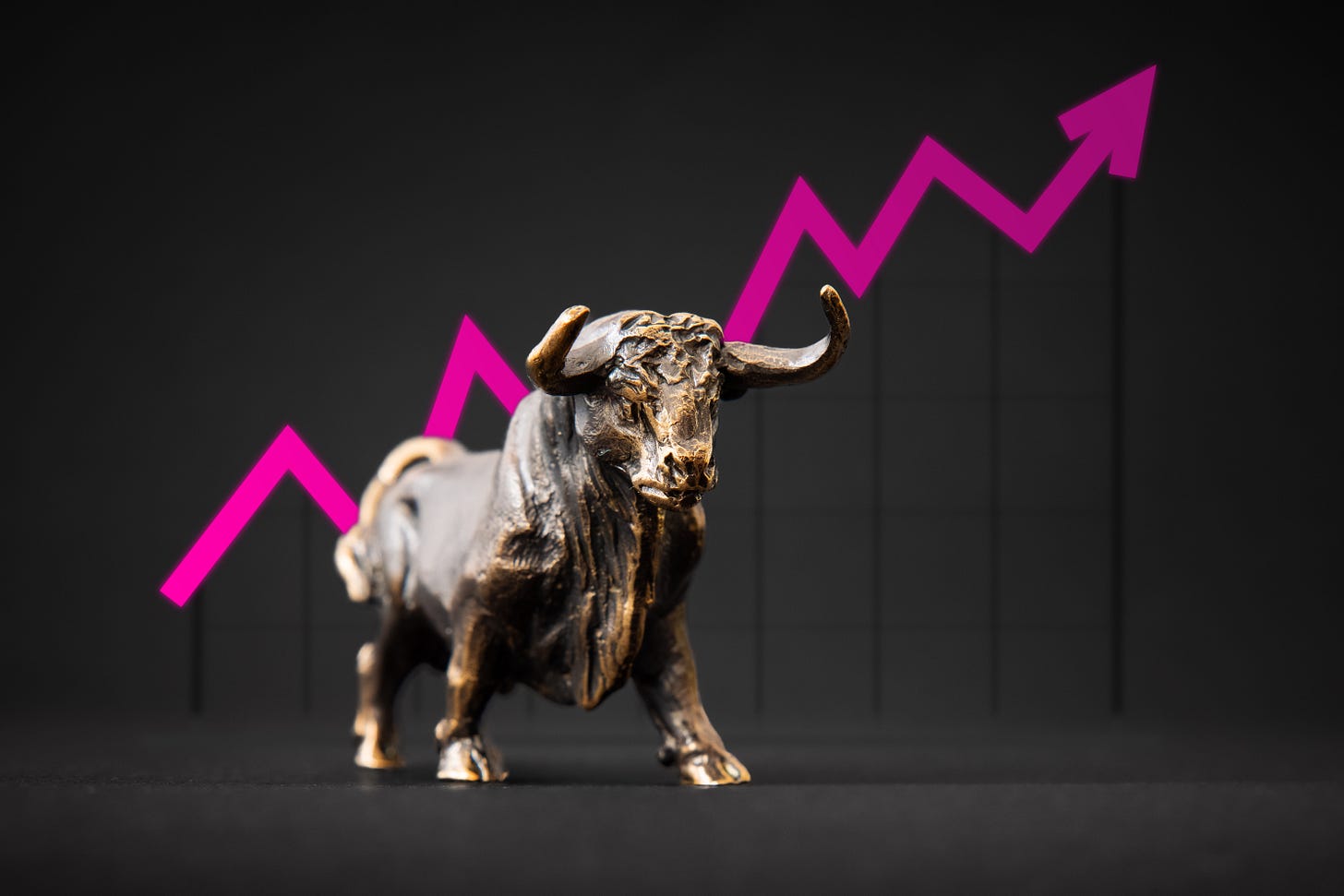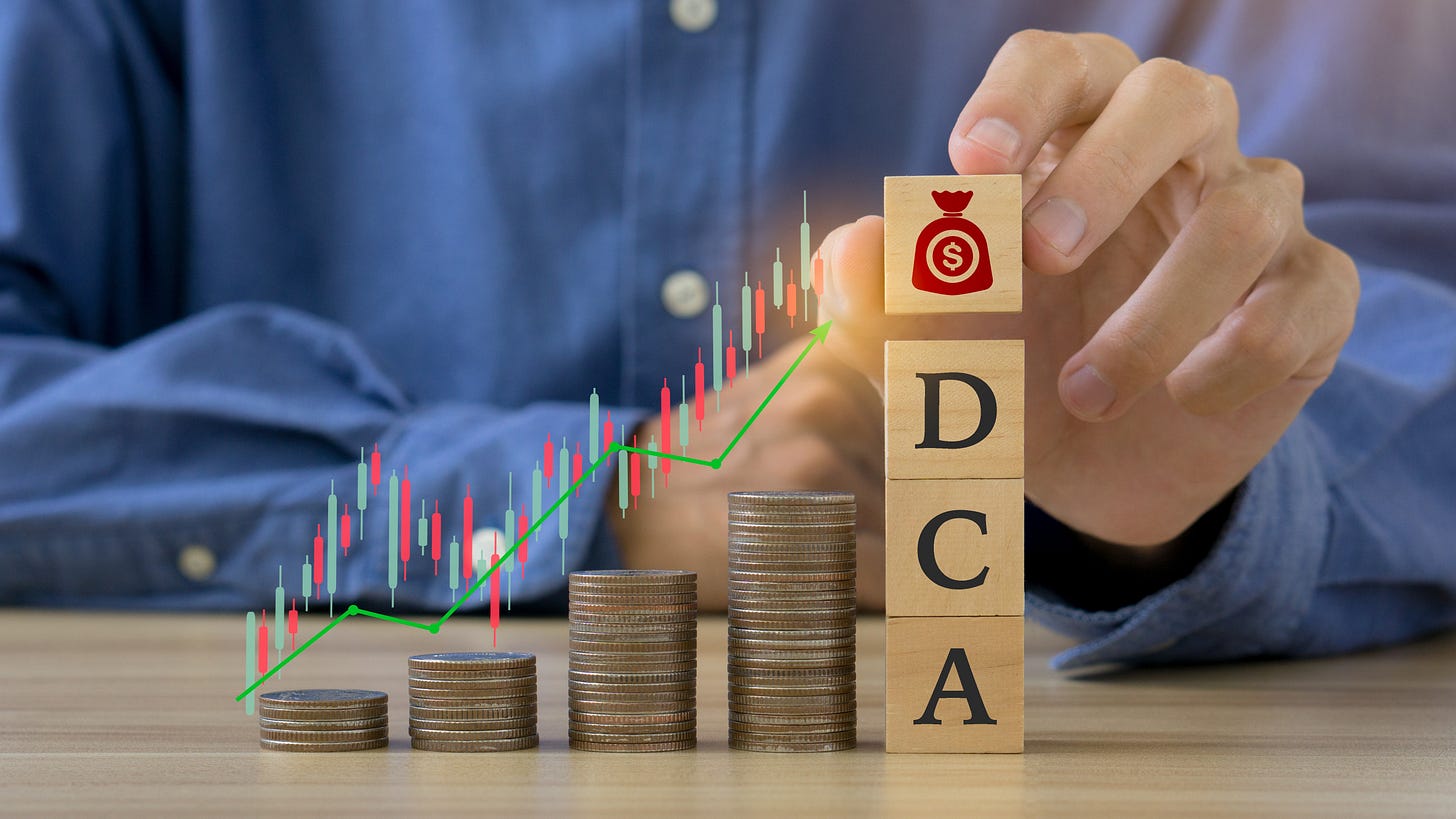Sensei’s Morning Forecast: Lump Sum vs. DCA—The Wealth Trap No One Warns You About
From Nasdaq’s new highs to China’s energy pivot and XRP ETF judgment day—today’s newsletter unpacks the market’s biggest moves and why your investing strategy might need rethinking.
🧠 One Big Thing
Research challenges the gospel of dollar-cost averaging (DCA)—long considered a go-to strategy for retail investors wary of market timing. Studies from Vanguard, PWL Capital, and JP Morgan consistently show that lump-sum investing (LSI) outperforms DCA in roughly two-thirds of historical periods, with average returns beating DCA by 4–8% when it does. Even in major bear markets like 2008 and the COVID crash, LSI delivered higher long-term outcomes in most scenarios. The core issue? Opportunity cost. Spreading investments over time sacrifices compound returns on idle capital, even when markets are volatile. While DCA provides psychological comfort via loss aversion and regret minimization, the math is clear: LSI maximizes wealth accumulation more reliably—even when markets are down.
💰 Money Move of the Day
Historical data shows lump-sum investing has outperformed dollar-cost averaging in most scenarios—even at market peaks. The key factor? Idle capital often misses early compound gains.
Today’s Deep Dive unpacks the numbers behind this surprising edge—and why the strategy most investors feel is safest might actually be costing them thousands.
📊 Market Snapshot
Cryptocurrencies:
Bitcoin (BTC): $107,095 (▲ +0.88%)
Ethereum (ETH): $2,424 (▼ -1.08%)
XRP: $2.19 (▲ +0.04%)
Equity Indices (Futures):
S&P 500 (SPX): 6,103 (▲ +0.21%)
NASDAQ 100: 22,487 (▲ +0.33%)
FTSE 100: 8,757 (▼ -0.08%)
Commodities & Bonds:
10-Year US Treasury Yield: 4.308% (▲ +0.28%)
Oil (WTI): $65.75 (▼ -0.68%)
Gold: $3,326 (▲ +0.08%)
🕒 Data as of UK (BST): 13:15 / US (EST): 08:15 / Asia (Tokyo): 21:15
✅ 5 Things to Know Today
NATO’s 5% Shockwave: Defense Stocks and Cybersecurity Enter a New Era
NATO Commits to Historic 5% Defense Spending Target by 2035
NATO allies endorsed a 5% of GDP defense spending target at the June 24–25 summit in The Hague, splitting the allocation into 3.5% for core military capabilities and 1.5% for security-related infrastructure by 2035 (Reuters, News4Jax). Spain secured an exemption from the target, and Belgium and Slovakia raised compliance concerns (AP). Trump, fresh off an Israel-Iran ceasefire announcement, criticized Spain’s opt-out and suggested the U.S. shouldn't be held to the same standard, despite current U.S. defense spending at 3.2–3.4% of GDP (CNN, Fortune). NATO also announced €4.7 billion in new munitions contracts, a joint acquisition effort for critical raw materials, and over €955 million in contributions to Ukraine’s Comprehensive Assistance Package (Defence Industry Europe, NATO).
Defense and Cybersecurity Stocks Enter Multi-Year Growth Cycle
European defense equities have rallied 45% YTD, driven by NATO's 5% pledge, with BAE Systems (1,816.50p) and Rheinmetall (€1,738.50) among the top performers (Fool UK, Morningstar). U.S. players like Lockheed Martin ($460.20) and Northrop Grumman ($499.80) show steady positioning, while Thales and Leonardo posted 74.32% and 115.94% gains respectively (CoinPriceForecast, TradingView). Defense ETFs—Themes NATO (+35%) and Select STOXX EUAD (+65%)—are outperforming broad indices (ETF.com, Zacks). Cybersecurity is a key beneficiary of the 1.5% infrastructure carve-out, with the Global X Cybersecurity ETF (BUGG) up 8.2% and firms like Palantir securing billion-dollar government contracts (Financial Newswire, Entrepreneur).
Sensei’s Insight:A 5% GDP defense commitment isn’t just posturing—it’s a structural capital shift. Defense and cybersecurity names are no longer niche rotation plays; they’re core allocations in a re-armed economic order.
China Rethinks Energy Strategy Amid Middle East Turmoil
The Israel-Iran conflict has prompted China to accelerate long-stalled negotiations on Russia’s Power of Siberia 2 pipeline, underscoring Beijing’s exposure to Middle Eastern energy risks. The 50 bcm/year pipeline, stalled since 2019 due to pricing disputes, is regaining momentum as Beijing seeks alternatives to unstable Gulf supplies (Reuters, Meduza). China currently sources 40–50% of its crude oil and 30% of its natural gas from the Middle East, much of it routed through the Strait of Hormuz—threatened by Iran during the recent escalation (AINvest, Energy News Beat, The Asia Live). In Q1 2025 alone, 5.4 million bpd of Chinese oil imports passed through the strait, prompting evacuations of over 3,000 citizens from Iran.
Pipeline Deal Gains Urgency Driven by security concerns, Beijing is expected to finalize terms with Moscow on Power of Siberia 2 by year-end (Fakti.bg, TASS, Reuters). The strategic shift favors Russian energy firms such as Gazprom while potentially decreasing China’s LNG intake from the Gulf, pressuring suppliers across global markets (SPGlobal, IntelliNews). Energy infrastructure developers and pipeline operators stand to benefit, while the geopolitical realignment signals a new era in Eurasian gas dynamics (Carnegie, Energy News Beat, Russia’s Pivot to Asia).
Sensei’s Insight: Beijing’s accelerated push on Power of Siberia 2 is more than crisis management—it’s a structural energy pivot. When over 5 million barrels a day of your oil floats through a chokepoint Iran can shut with a threat, redundancy isn’t a luxury—it’s policy. This pipeline isn’t just steel in the ground; it’s China’s insurance policy against Strait-of-Hormuz risk, U.S. naval dominance, and LNG market volatility. For investors, follow the welders: infrastructure players, Russian gas majors, and Asian pipeline financiers just got handed a megaproject roadmap—one that runs right through Siberia.
NYC Democrat Mamdani Topples Cuomo in Stunning Primary Upset
Democratic Socialist state Assemblyman Zohran Mamdani, 33, declared victory in New York City's Democratic mayoral primary Tuesday night after former Governor Andrew Cuomo conceded defeat in one of the biggest political upsets in recent NYC history (AP News, CNN). Mamdani secured 43.5% of first-choice votes compared to Cuomo’s 36.3%, while City Comptroller Brad Lander placed third at 11% (Politico, ABC News). Although ranked-choice vote counting will continue until July 1, Cuomo’s concession effectively cedes the Democratic nomination to Mamdani, who ran on a staunchly anti-establishment platform (Wikipedia, Wikipedia).
If elected in November, Mamdani would become NYC’s first Muslim, first Asian, first millennial, and first Democratic Socialist-affiliated mayor since 1993 (TIME). His grassroots campaign raised over $20 million from 20,000+ individual donors averaging $80 each—starkly contrasting with Cuomo’s $25 million super PAC backed by figures like Michael Bloomberg (NYT, NYT Live). Mamdani’s agenda includes raising NYC corporate taxes to 11.5%, implementing a 2% millionaire tax, and freezing rents on over one million stabilized units (Zohran for NYC, TIME). Most notably, he proposes issuing $70 billion in municipal bonds to build 200,000 affordable housing units—on top of the city’s $136.2 billion in bond authorization (Bloomberg, AINVEST). This could strain REITs, widen muni spreads, and hit large NYC-based firms, while potentially favoring ESG and solar infrastructure funds through his $3.27 billion school retrofitting plan (NY Post, AINVEST).
Sensei’s Insight: Mamdani’s proposal to issue $70 billion in new municipal bonds signals a historic expansion of NYC’s debt load, with major implications for muni markets. Investors face rising credit risk, potential rating pressure, and shifting ESG narratives. For firms tied to NYC—especially in real estate and finance—the tax and regulatory landscape may soon look very different.
SEC XRP ETF Judgment Day: Make-or-Break Moment for Altcoin ETFs
The U.S. Securities and Exchange Commission faces a pivotal decision today, June 25, 2025, on ProShares' spot XRP ETF application. This deadline, triggered by a June 10 filing from ProShares, sets June 25 as the effective date for both its XRP and Solana ETF proposals (CryptoTimes, CryptoNews). The SEC must now approve, deny, or extend the review—ending the procedural limbo. This move comes amid a wave of crypto ETF applications in 2025, including Franklin Templeton's XRP ETF, whose June 17 deadline was pushed to late July after a public comment period was opened (Cointelegraph, CryptoTimes). Unlike Franklin Templeton, ProShares has held firm on the June 25 target, backed by updated filings. Bloomberg’s James Seyffart and Eric Balchunas now estimate approval odds for most crypto ETFs—including XRP—at 90%+ due to heightened SEC engagement (CoinDesk, TheCryptoBasic).
Why This Matters to Investors
An SEC approval today would mark the first spot XRP ETF in the U.S., a move expected to catalyze institutional capital flows akin to those seen with Bitcoin and Ethereum ETFs. Bloomberg analysts estimate that XRP could rally significantly if its ETFs capture even 35% of Bitcoin ETF inflows (TheCryptoBasic). Conversely, a delay would underscore ongoing SEC hesitancy toward altcoin ETFs, dampening investor enthusiasm for the broader “Altcoin ETF Summer” narrative. The outcome also sets precedent for other XRP ETF proposals from Bitwise, Grayscale, and 21Shares, which face final deadlines extending through October 2025 (TheCryptoBasic).
Sensei’s Insight: A green light from the SEC today could trigger a ripple effect—both figuratively and literally—across the ETF landscape. With 90%+ approval odds and a tightly held June 25 deadline, ProShares' XRP ETF could become the catalyst that opens institutional floodgates to altcoins. Traders betting on the “Altcoin ETF Summer” theme should watch this decision like a hawk.
📈 Nasdaq 100 Hits Record High on Ceasefire Rally
The Nasdaq 100 closed at a record high of 22,190.52 on Tuesday, rising 1.5% and marking its first all-time closing high since February 19 (Investopedia, MarketScreener, Reuters). The tech-heavy index surpassed its previous record close of 22,175.60, driven by investor optimism following a ceasefire agreement between Israel and Iran that reduced geopolitical tensions and sparked a broad risk-on rally (MarketScreener, Reuters). The index recorded 7 new highs with no new lows, as 89 stocks advanced while only 12 declined, creating an advancing-to-declining ratio of approximately 7.4-to-1 (Reuters).
Technology stocks led the surge, with nearly all Magnificent Seven companies posting gains. Nvidia climbed 2.6% to $147.90, reaching its highest level since January and nearing its record close of $149.43 (Investopedia, Wall Street Pit). Microsoft gained nearly 1% to set a new all-time high, while Amazon and Meta each added approximately 2%, and Alphabet tacked on 1% (Investopedia). The semiconductor sector saw particularly strong performance, with Intel surging 6.7%, AMD jumping 6.3%, and Broadcom advancing 4% to a record high (Investopedia, Reuters, Wall Street Pit). The PHLX Semiconductor Index gained 3.8% as investors embraced renewed confidence in chip demand (Investopedia).
This rally represents a significant turnaround for the index, which had fallen as much as 23% from its previous peak amid concerns over President Trump's global tariffs (Reuters, Bloomberg). The breakthrough above 22,190 signals a complete recovery from April's tariff-related selloff and puts the index on track for its strongest annual performance since 1999, when it achieved a 102% gain (TradingView). The current momentum, combined with strong corporate earnings expectations and reduced geopolitical risk, positions the tech sector for continued outperformance as investors rotate back into growth assets after months of uncertainty.
Sensei’s Insight: When geopolitical tensions ease, markets often respond with aggressive optimism—but this week’s rally tells a deeper story. The Nasdaq 100’s fresh all-time high wasn’t just about a ceasefire; it was a declaration of tech’s continued dominance. With Nvidia, AMD, and Broadcom breaking out and Microsoft tagging new highs, the semiconductor and cloud engines are proving they still have torque. More importantly, the index has fully retraced its tariff-driven losses, signaling resilience in the face of macro threats. For disciplined investors, the lesson is clear: geopolitics may shake the tree, but fundamentals still pick the fruit.
🔗 Connect with Us
Stay plugged in across platforms:
Sensei on X: sensei_crypto_
Martyn Lucas on X: MartynInvestor
Vaz on X: eVTOLHUB
💎 Premium Discord Access: Join the Discord
📺 YouTube Channel (Live & Replays): Martyn Lucas Investor
👕 Limited Merch: Shop Here
🔍 Deeper Dive: Why Dollar-Cost Averaging May Be Overrated: A Data-Driven Analysis
Dollar-cost averaging has become retail investing's most popular strategy, yet rigorous research reveals it's often mathematically inferior to lump-sum investing—even during the market crashes investors fear most.
Keep reading with a 7-day free trial
Subscribe to Sensei’s Insights to keep reading this post and get 7 days of free access to the full post archives.











